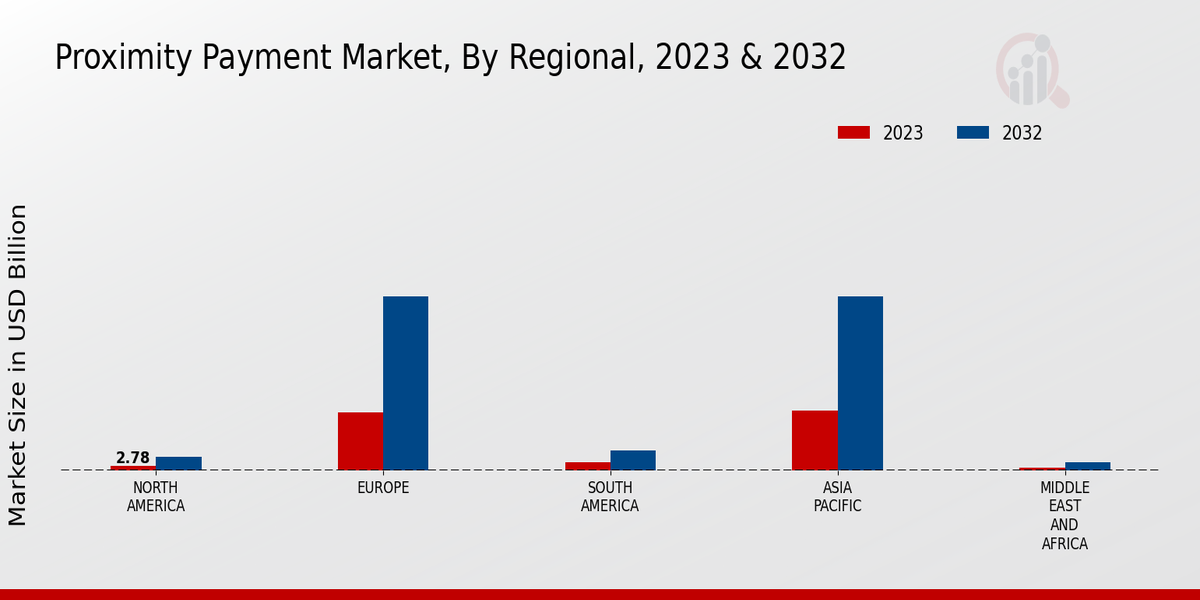Market Growth Projections
The Global Proximity Payment Market Industry is projected to experience robust growth over the coming years. In 2024, the market is anticipated to reach 36.9 USD Billion, with expectations of expanding to 137.8 USD Billion by 2035. This growth trajectory suggests a compound annual growth rate (CAGR) of 12.72% from 2025 to 2035. Such projections indicate a strong demand for proximity payment solutions across various sectors, driven by technological advancements and changing consumer behaviors. The market's expansion reflects the increasing importance of efficient and secure payment methods in a rapidly evolving digital economy.
Increasing Adoption of Mobile Wallets
The Global Proximity Payment Market Industry experiences a notable surge in the adoption of mobile wallets, driven by consumer preferences for convenience and speed in transactions. In 2024, the market is projected to reach 36.9 USD Billion, reflecting a growing inclination towards cashless payments. Major players like Apple Pay and Google Wallet are leading this trend, offering seamless integration with smartphones. This shift not only enhances user experience but also encourages retailers to adopt proximity payment solutions, thereby expanding the market further. As consumers increasingly favor mobile wallets, the Global Proximity Payment Market Industry is likely to witness sustained growth.
Rising Demand for Contactless Payments
The Global Proximity Payment Market Industry is significantly influenced by the rising demand for contactless payment solutions. Consumers increasingly prefer contactless transactions due to their speed and convenience, particularly in retail environments. This trend is evident as businesses implement contactless payment systems to enhance customer satisfaction and streamline operations. According to industry data, contactless payments are expected to account for a substantial portion of the market share in the coming years. As this demand continues to grow, the Global Proximity Payment Market Industry is likely to expand, with a projected CAGR of 12.72% from 2025 to 2035.
Expansion of E-commerce and Retail Sectors
The expansion of e-commerce and retail sectors is a driving force behind the growth of the Global Proximity Payment Market Industry. As online shopping becomes increasingly prevalent, retailers are adopting proximity payment solutions to cater to consumer preferences for quick and efficient transactions. This trend is particularly evident in urban areas, where consumers seek seamless shopping experiences. The integration of proximity payment options in e-commerce platforms further enhances convenience, driving sales and customer loyalty. As the retail landscape evolves, the Global Proximity Payment Market Industry is likely to see substantial growth, supported by the increasing integration of payment technologies.
Technological Advancements in Payment Solutions
Technological innovations play a pivotal role in shaping the Global Proximity Payment Market Industry. The introduction of Near Field Communication (NFC) technology has revolutionized how transactions are conducted, allowing for quick and secure payments. In 2024, the market is expected to benefit from advancements in biometric authentication and encryption technologies, enhancing security and user trust. This technological evolution not only attracts consumers but also incentivizes businesses to adopt proximity payment systems. As a result, the Global Proximity Payment Market Industry is poised for substantial growth, with projections indicating a market size of 137.8 USD Billion by 2035.
Government Initiatives Promoting Digital Payments
Government initiatives aimed at promoting digital payment solutions significantly impact the Global Proximity Payment Market Industry. Various countries are implementing policies to encourage cashless transactions, thereby enhancing financial inclusion and economic growth. For instance, initiatives such as the Digital India campaign have led to increased adoption of proximity payment methods among consumers and businesses alike. These efforts not only foster a favorable regulatory environment but also stimulate investments in payment infrastructure. Consequently, the Global Proximity Payment Market Industry is expected to thrive as governments continue to support the transition towards digital payments.


























